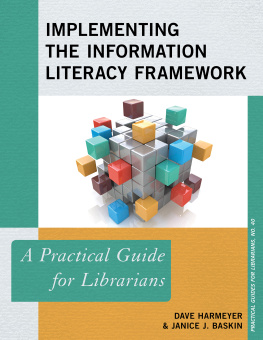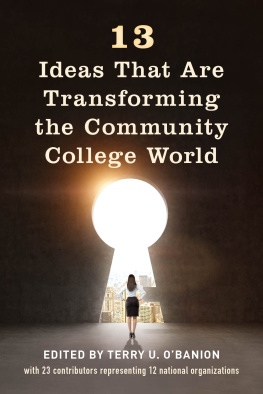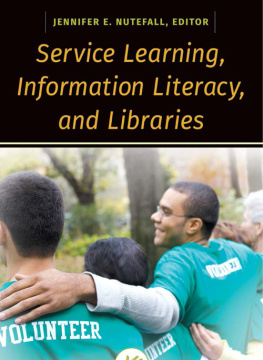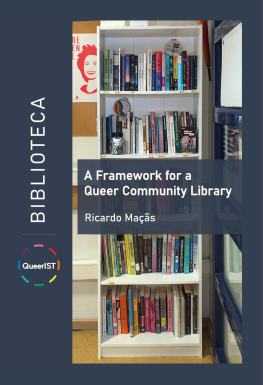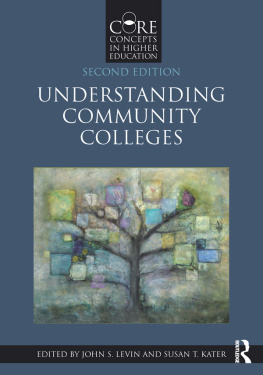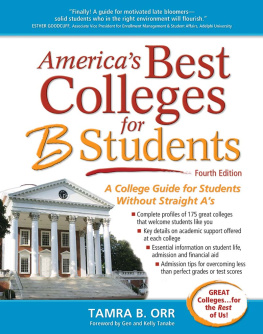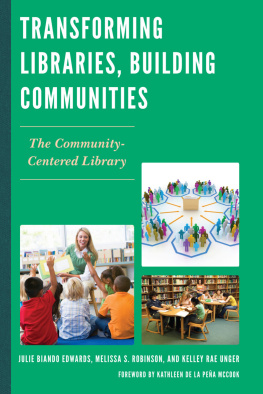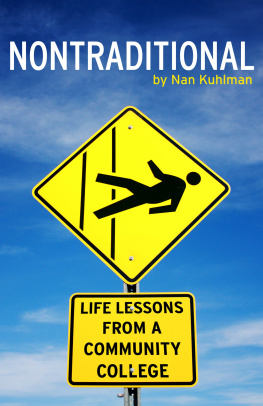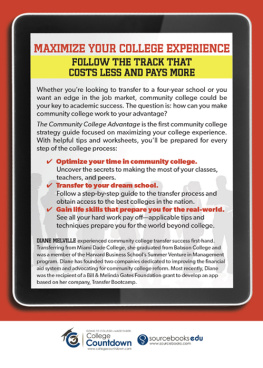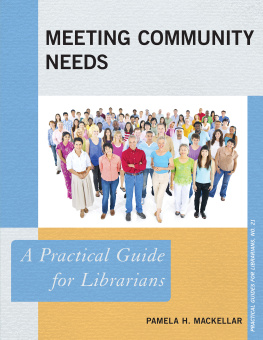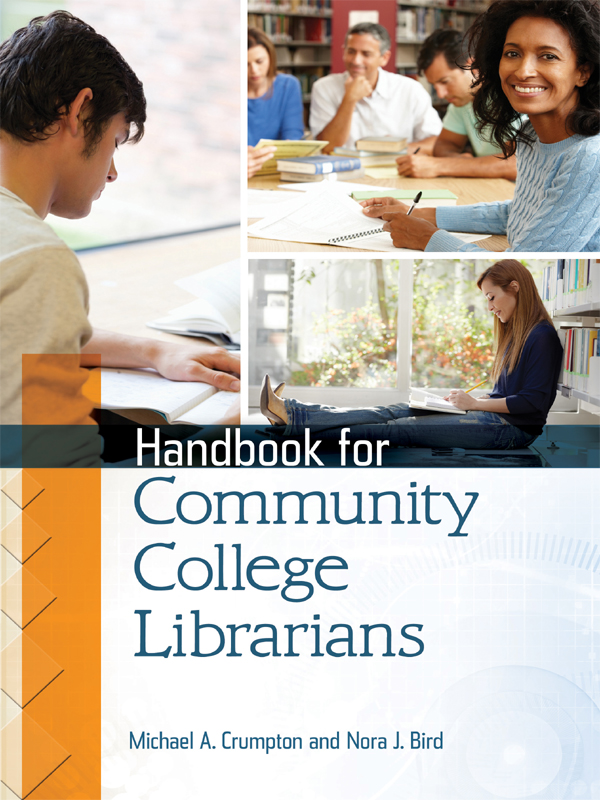
HANDBOOK FOR COMMUNITY COLLEGE LIBRARIANS
HANDBOOK FOR COMMUNITY COLLEGE LIBRARIANS

Michael A. Crumpton and Nora J. Bird

AN IMPRINT OF ABC-CLIO, LLC
Santa Barbara, California Denver, Colorado Oxford, England
Copyright 2013 by Michael A. Crumpton and Nora J. Bird
All rights reserved. No part of this publication may be reproduced, stored in a retrieval system, or transmitted, in any form or by any means, electronic, mechanical, photocopying, recording, or otherwise, except for the inclusion of brief quotations in a review, without prior permission in writing from the publisher.
Library of Congress Cataloging-in-Publication Data
Crumpton, Michael A.
Handbook for community college librarians / Michael A. Crumpton and Nora J. Bird.
pages cm
Includes bibliographical references and index.
ISBN 9781610693455 (pbk.)ISBN 9781610693462 (ebook) 1. Community college librariesHandbooks, manuals, etc. I. Bird, Nora J. II. Title.
Z675.J8C78 2013
027.7dc23 2013027457
ISBN: 9781610693455
EISBN: 9781610693462
17 16 15 14 13 1 2 3 4 5
This book is also available on the World Wide Web as an eBook.
Visit www.abc-clio.com for details.
Libraries Unlimited
An Imprint of ABC-CLIO, LLC
ABC-CLIO, LLC
130 Cremona Drive, P.O. Box 1911
Santa Barbara, California 93116-1911
This book is printed on acid-free paper 
Manufactured in the United States of America
CONTENTS
ILLUSTRATIONS
LIST OF FIGURES
LIST OF TABLES
LIST OF SIDEBARS
PREFACE
The genesis of this book was the authors shared history working in community college libraries. We both currently work for the University of North Carolina at Greensboro (UNCG), a doctoral-level university of about 17,000 students; Michael Crumpton as assistant dean in the University Libraries and Nora Bird as an assistant professor in the Department of Library and Information Studies (LIS). The University Libraries and the LIS Department had jointly applied for and received a large grant, called the ACE Scholar program, from the Institute of Museum and Library Studies (IMLS) focused on bringing diversity to academic library staffs. In September 2009, we thought a similar grant could be proposed that would focus specifically on community colleges. One part of the grant was to look at the competencies necessary to be a successful community college librarian in the twenty-first century. A copy of the grant proposal from 2010 is included as at the end of this book.
While in the process of writing the grant, we realized that the research on community college libraries was sparse. Community college librarians often do not have requirements to publish as part of their contract or tenure requirements. We felt that before we could educate new community college librarians, we needed to add to our own understanding of the environment and the skill set needed to succeed within it. We devised a wide-ranging survey that was sent to the Community and Junior College Section listserv. Partial information gained from this survey called the 21st Century Community College Librarian is provided as at the end of the book.
We followed up that inquiry with focus groups with librarians from the North Carolina Community College Learning Resources Association. We launched the website Defining the Community College Librarian. We became particularly interested in the question of information literacy for vocational students and presented at conferences and wrote on that topic.
With our new understanding, we again wrote a grant application for IMLS funding with a shorter timeline. Although we were turned down again, we planned and offered LIS 652 Management Seminar: Community College Librarianship to UNCG LIS students. The outline for that course is the outline of this book. In 2013, shortly before the publication of this book, the authors were awarded an IMLS grant focused on diversity in community college librarianship. The curriculum, including LIS 652, will prepare ten students for the challenging role played by community colleges.
From the beginning, we shared a common view of community colleges as vital institutions that need competent librarians. We found in our survey that many of those already serving in that capacity had been doing so for more than 25 years, and many were ready for retirement. Part of the grant application had been the introduction of a special kind of internship, called Real Learning Connections, which would pair practicing librarians and student interns in a joint effort to learn. The proven model on which it is based is that the librarian teaches with specific learning objectives but so do the students by sharing their own expertise in technology, social media, and research with the practicing librarian. Each would acknowledge that they could learn from the other and create shared goals that could be accomplished together during the internship. Librarianship is at a generational crossroads, and the internship is the place where librarians and apprentices can meet and learn from each other.
We simulated these internships in an abbreviated way when we taught the community college library course. We incorporated a series of conversations between practicing librarians and students that the students had to report on for the class. It was wonderful to see those conversations deepen as we progressed through the semester.
This book is not simply a textbook; there is much more to it. The topics that we cover are certainly part of learning to be a community college librarian. We call it a handbook so that practicing librarians can feel that their work is represented here and that they could stretch their knowledge to incorporate new processes and procedures. We hope that every reader can learn new things about how to create collections, how to teach, and how to manage in the dynamic community college environment. We hope that we have succeeded.
ACKNOWLEDGMENTS
We would like to thank our colleagues from all over the country for informing this work at every step including Dr. David Wright, Suvanida Duangudom, Jackie Case, Julie Obst, Bonnie Sanguinet, Marilyn Carney, Barbara Grether, Cathy Campbell, Laurie Williams, and Jennifer Arnold. We especially thank Jennifer Noga, Gerald Holmes, Natalie Blas, Jim Carmichael, Derek Long, Heather Hans, and Beth Martin for their comments and suggestions on early drafts of this manuscript. We would like to thank our students in LIS 652 who helped us to determine what was important and should be included here. Thanks especially to Tim Williams, now a community college librarian and formerly a student and graduate assistant, for all of his work during the last two years. Finally, we would like to thank our spouses, Robert Cary and Leslie Crumpton, for their love and support through this effort.

INTRODUCTION
In this book, you will be introduced to or reacquainted with the dynamic environment of community college libraries. The most broadly used term, community college, has been adopted because the National Center for Education Statistics (NCES) uses it to describe a number of slightly different two-year institutions that may be called city colleges, technical colleges, or junior colleges (Provasnik and Planty 2008). Although publicly funded colleges are the primary focus, many of the topics covered in this book can be applied to proprietary, or for-profit, and private, nonprofit schools that work with two- or four-year students. According to the NCES and the Carnegie Foundation for the Advancement of Teaching, there are more than 1,100 such institutions in the United States, with many having more than one campus. According to the American Association of Community Colleges, their membership includes 986 public community colleges, 31 tribal colleges, and 115 independent colleges.
Next page

